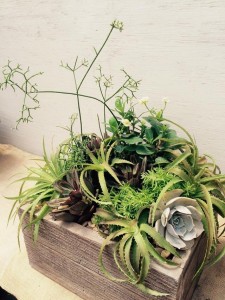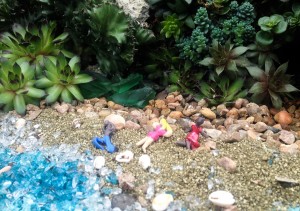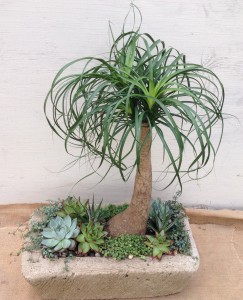
Made out of cedar…
Even an ordinary day can bring pleasant surprises. Every now and then people stop by, peddling items they’ve created, hoping we’ll carry them. We try some, hoping they’ll be a good fit for our location and things our customers will like. Some work for us; some don’t.
The other day a gentleman stopped in with his truck loaded with beautiful hypertufa pots of all sizes and cedar frames planted with hen and chick succulents, sempervivums. Right away I knew these were right up our alley! If you’re on Pinterest (Oak Street Garden Shop is!), you no doubt have seen succulents of all sorts in many combinations. Whoever the very first person was who came up with this great idea deserves a prize!
These frames are made of long-lasting cedar, are lightweight, and are actually designed to stand on a table like a picture. Even set completely flat they could be a beautiful centerpiece. The planting box also has drainage holes so plants won’t get waterlogged.

Little cedar boxes wrapped with burlap and planted with sempervivums also caught our eye. Really such a simple idea…and so pretty. We’d like to also get more of the cedar planters with metal fronting; they are fantastic looking!

Rounding out the offerings were different sizes of planted hypertufa pots. The tiny pots with one sempervivum are just the right size for party favors or a “Thinking of you” gift. There were also a selection of larger pots, some wrapped with burlap with the addition of a medallion for added interest.
Fortunately, this gentleman used to work for one of our excellent wholesale plant suppliers in Alabama years ago and has a lot of experience growing quality plants. Taking this knowledge a step further and offering planted containers was certainly a natural progression. After a move to Georgia and time spent working in garden center retailing, he and his brother are back in Alabama with this new, local business. We wish them the best of luck!
if you’re in the Birmingham area, stop in and take a look at these pretty plantings from our newest local supplier!



 While parts of the country are enjoying an unusually cool summer, here in the heart of the south the temperature and humidity can still soar. Unfortunately, even nighttime temperatures rarely provide respite from the unending heat, though, thankfully, we (and our plants!) have had a couple of welcome breaks this year.
While parts of the country are enjoying an unusually cool summer, here in the heart of the south the temperature and humidity can still soar. Unfortunately, even nighttime temperatures rarely provide respite from the unending heat, though, thankfully, we (and our plants!) have had a couple of welcome breaks this year. While there are plenty of
While there are plenty of The basket planting shows a tiny leaf blue-green succulent-like plant that is actually a Pilea called ‘Aquamarine’. It has fast become a favorite for succulent and other arrangements in containers. The tiny leaves grow quite quickly, mingling with other plants and eventually trailing, seemingly indefinitely! This mixture also has echevarias, workhorse succulents that can grow to enormous proportions.
The basket planting shows a tiny leaf blue-green succulent-like plant that is actually a Pilea called ‘Aquamarine’. It has fast become a favorite for succulent and other arrangements in containers. The tiny leaves grow quite quickly, mingling with other plants and eventually trailing, seemingly indefinitely! This mixture also has echevarias, workhorse succulents that can grow to enormous proportions.
 Succulent plants and
Succulent plants and  The wooden bowl shows an old favorite, sempervivum or hen and chicks, a well known succulent and widely available in many rosette colors. One thing we’ve learned about “semps” is they really do appreciate a bit of shade in the afternoon here in Birmingham. Maybe it’s our constant humidity. At any rate, a touch of shade seems to help.
The wooden bowl shows an old favorite, sempervivum or hen and chicks, a well known succulent and widely available in many rosette colors. One thing we’ve learned about “semps” is they really do appreciate a bit of shade in the afternoon here in Birmingham. Maybe it’s our constant humidity. At any rate, a touch of shade seems to help. Another cactus called ‘Old Man’ and a little succulent called Haworthia are at home in a small marble container. There are no drainage holes in this piece, so careful watering must be done sparingly.
Another cactus called ‘Old Man’ and a little succulent called Haworthia are at home in a small marble container. There are no drainage holes in this piece, so careful watering must be done sparingly. Finally, a long, very narrow piece of cork bark is home to a varied selection of succulents including Portulacaria afra, sometimes called miniature variegated jade plant though it’s a different species. Its small, cream-variegated leaves on reddish stems are striking combined with the echevarias, haworthias, Cryptanthus, and Senecio rowleyanus or string of pearls (not shown in this picture). With bright light and a light hand with water, this planting should flourish.
Finally, a long, very narrow piece of cork bark is home to a varied selection of succulents including Portulacaria afra, sometimes called miniature variegated jade plant though it’s a different species. Its small, cream-variegated leaves on reddish stems are striking combined with the echevarias, haworthias, Cryptanthus, and Senecio rowleyanus or string of pearls (not shown in this picture). With bright light and a light hand with water, this planting should flourish.




 Jamie put together this stunning display the other day at the front of the shop, using a beautiful mix of containers and plants. The picture doesn’t do her designs justice,,,a pony tail palm underplanted with succulents; another succulent planting in cork bark; and a gorgeous arrangement of a standing cork bark planter with brassidium, or spider, orchids.
Jamie put together this stunning display the other day at the front of the shop, using a beautiful mix of containers and plants. The picture doesn’t do her designs justice,,,a pony tail palm underplanted with succulents; another succulent planting in cork bark; and a gorgeous arrangement of a standing cork bark planter with brassidium, or spider, orchids.
 This closeup picture of the succulent plantings shows both the diversity of this group of plants and why we enjoy working with them so much. In addition to the drought tolerant ponytail palm, there are echeverias, string of pearls, string of bananas, crassulas, and variegated trailing jade plant, all right at home in her design.
This closeup picture of the succulent plantings shows both the diversity of this group of plants and why we enjoy working with them so much. In addition to the drought tolerant ponytail palm, there are echeverias, string of pearls, string of bananas, crassulas, and variegated trailing jade plant, all right at home in her design.














 Because succulents, air plants and even
Because succulents, air plants and even 








 These cork bark pieces are so organic and natural…we love them and wanted to pass on just a couple of ideas for planting them. Actually, they were one of those happy accidents – one wrong stroke of the keyboard, with a different item number ordered than planned, and, voila, these cork bark pieces arrived the other day that were rounded, with just enough space for planting rather than being flat…oh, happy day!
These cork bark pieces are so organic and natural…we love them and wanted to pass on just a couple of ideas for planting them. Actually, they were one of those happy accidents – one wrong stroke of the keyboard, with a different item number ordered than planned, and, voila, these cork bark pieces arrived the other day that were rounded, with just enough space for planting rather than being flat…oh, happy day! Of course, if you’ve been keeping up with previous posts, you know we’ve gotten in some pretty cool looking succulents, as well as air plants and the beginning of the new season’s herb offerings. So, with all this bounty to work with, one bark planter became a succulent, herb, airplant design and the other became a study in silvery grays and blues with a pop of chartreuse…
Of course, if you’ve been keeping up with previous posts, you know we’ve gotten in some pretty cool looking succulents, as well as air plants and the beginning of the new season’s herb offerings. So, with all this bounty to work with, one bark planter became a succulent, herb, airplant design and the other became a study in silvery grays and blues with a pop of chartreuse…
 As with any combination planting, look at color, texture and form of the plants you’re working with. The bark is rough and brown…in one planting the red coloring of the hens and chicks play off the brown of the planter while the red edging of the thyme also picks up the color of the succulents. The spiky air plants contrast with the rounded forms of the rolled bark as well.
As with any combination planting, look at color, texture and form of the plants you’re working with. The bark is rough and brown…in one planting the red coloring of the hens and chicks play off the brown of the planter while the red edging of the thyme also picks up the color of the succulents. The spiky air plants contrast with the rounded forms of the rolled bark as well.